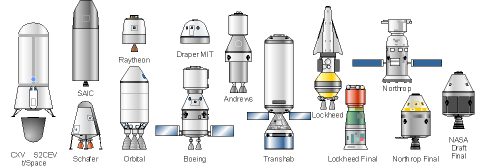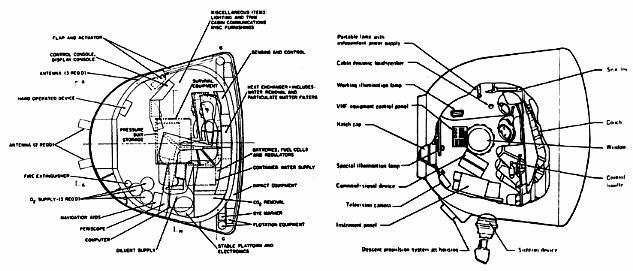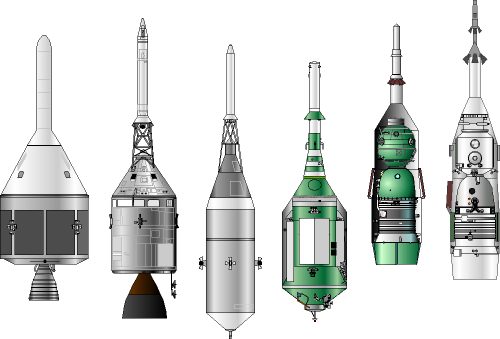Over at Enyclopedia Astronautica is an incredible (well, incredible to anyone not au fait with US Space program mismanagement) tale of repeating mistakes till the situation is FUBAR.
Here's the story:
The selection of an Apollo-type configuration for the re-entry vehicle represented a step back sixty years. The original Apollo design, a NASA in-house concept, was inferior to contractor alternatives. The Soviets selected the Soyuz configuration (identical to the losing General Electric Apollo design) and had a configuration still in production fifty years later - and likely to continue to the middle of the 21st Century in the Chinese Shenzhou. Apollo, by comparison, remained in production only five years. In 2005, Northrop-Grumman again proposed a Soyuz-type design.
Other alternatives for Apollo were a variety of ballistic, lifting-body and winged configurations, any of which would have provided a fine basis for a manned spacecraft that could be recovered with horizontal landings. At least the excuse given in 1961 - that there was no time to pursue development of a winged vehicle and still make the end-of-the-decade lunar landing deadline - may have had some validity. But this made less sense in 2005, when Lockheed proposed a winged design based on forty years of intervening lifting body research and shuttle hypersonic flight experience.
In more detail :
When NASA was instructed to go to the moon in April 1961, the Apollo capsule design concept had already been selected. It was to be a general-purpose spacecraft, with a crew of three. The crew of three was selected for no other reason than NASA assumed that one crewmember would have to be awake at all times to tend unreliable automatic spacecraft systems, ergo three eight-hour shifts. The capsule had to have more space than required just to house three astronauts - enough for the crew to don and doff spacesuits on missions of up to two weeks. NASA's approach to the lunar landing mission took as its first assumption that the return capsule would be the Apollo, with a mass of five tonnes for three men.Image : NASA. Apollo Alternative Concepts
General Electric proposed an alternative Apollo design that cut the mass of a three-man return vehicle to three tonnes. This put all systems and space not necessary for re-entry and recovery outside of the re-entry vehicle, into a separate jettisonable 'mission module', joined to the re-entry vehicle by a hatch. Every gram saved in this way saved two or more grams in overall spacecraft mass - for it was mass that did not need to be protected by heat shields, supported by parachutes, or braked on landing. Weight was also saved through use of a re-entry vehicle of the highest possible volumetric efficiency (internal volume divided by hull area). Theoretically this would be a sphere. But re-entry from lunar distances required that the capsule be able to bank a little, to generate lift and 'fly' a bit. This was needed to reduce the G forces on the crew to tolerable levels. Such a maneuver is impossible with a spherical capsule. After considerable study, the optimum shape was found to be the Soyuz 'headlight' shape - a hemispherical forward area joined by a barely angled cone (7 degrees) to a classic spherical section heat shield.
This design concept meant splitting the living area into two modules - the re-entry vehicle, with just enough space, equipment, and supplies to sustain the crew during re-entry; and a mission module. As a bonus the mission module provided an airlock for exit into space and a mounting area for rendezvous electronics.
The end result of this design approach was remarkable. The Apollo capsule designed by NASA had a mass of 5,000 kg and provided the crew with six cubic meters of living space. A service module, providing propulsion, electricity, radio, and other equipment would add at least 1,800 kg to this mass for the circumlunar mission. The General Electric spacecraft provided the same crew with 9 cubic meters of living space, an airlock, and the service module for the mass of the Apollo capsule alone!
The modular concept was also inherently adaptable. By changing the fuel load in the service module, and the type of equipment in the mission module, a wide variety of missions could be performed. The same concept was adopted by the Soviets for their Soyuz capsule, and the Chinese for their Shenzhou. The superiority of this approach is clear to see: the Soyuz remains in use 40 years later, while the Apollo was quickly abandoned.
Incredibly, NASA made the same mistakes again, forty years later. But this time in spades. First, an assumption was made that a six-person crew would be needed to be returned from a Mars mission. Everything else derived from this initial assumption. Now in the first place, there is no logical basis for selecting six. Dozens of Mars expedition studies have been made over the years, with anywhere from three to seventy crew being recommended. Furthermore, there is no logic to insisting that the entire crew come back in a single re-entry vehicle. Finally, this Mars mission with six crew that have to come home together, is totally unfunded, unengineered, and at least twenty years in NASA's future. It was in 1968 as well. So using this ever-receding dream as the basis for your utility spacecraft design is jaw-dropping.
At this point in its internal studies, NASA was assuming a direct flight to the moon. A large booster would fire the CEV toward the moon, it would land directly on the surface, and then it would fire an ascent stage and return to earth. This was the least complex and the most operationally efficient - trips from the earth to the moon and back could be made at any time. Furthermore, the capsule would be a maximum of 5.0 m in diameter, so that it could be launched by the Delta IV or Atlas V EELV boosters just put into service by the United States. But then NASA claims it found that: "Layouts for a crew of six and the associated equipment and stowage were very constrained and left very little habitable volume for the crew. It was determined that the internal volume for the CM was too small, especially for a surface direct mission where the CEV would be taken to the lunar surface". So NASA moved on to Design Cycle 2, with a 5.5 m diameter, where: "The desire in this design cycle was to provide enough interior volume for the crew to be able to stand up in and don/doff lunar EVA suits for the surface direct mission".
So here we are right back at Apollo. A large crew defined for no particular reason. A requirement is conceived that the re-entry vehicle has to provide all of the space the crew will need for the entire mission. And finally, based only on "constrained" layouts, NASA decides Not Invented Here launch vehicles will be unsuitable and decides only its own special-design boosters will do.Now NASA had a capsule designed for six crew at some future date, but it discovered that it would need to only fly three crew to the ISS and four to the moon and back. Did NASA junk the 5.5 m design, and declare that it could use existing boosters after all? No, it plowed ahead with this six-crew capsule, and jinned up launch vehicles that would require existing shuttle components, facilities, and staff to make them fly. So it was clear that the mission was not to get to the moon, or support the ISS, but only to preserve NASA and NASA contractor jobs and facilities.
This doesn't even touch on the matter on the innovative designs that were suggested in the first round of CEV proposals that NASA will not even comment on. The same approach was used in Apollo. First, proposals from industry were solicited. In both the Apollo and CEV cases these were imaginative, innovative, and incorporated all of the lessons of hundreds of millions of dollars of advanced research funded not just by NASA, but also by industry and the US Air Force. Superior contractor designs using the Soyuz-type separate orbital module or a winged spaceplane approach were made in both cases. In the case of the CEV, the team that designed and flew SpaceShipOne on the first civilian manned spaceflight offered to build a complete (four-crew) air-launched booster and spacecraft that would do the job for one-fortieth of the CEV/CLV cost!. In both the Apollo and CEV cases the contractors were thanked, and NASA then proceeded with its own in-house government design. This was then suitably tweaked until it will passed the Congressional pork test.
It's difficult to come to any other conclusion than this is a project designed only to put pork in as many state pork barrels as possible. It is not designed to actually work, and I doubt it ever will.
The shape of the new, 21-st century CEV is derived from work done in the late 1950's. Essentially, the Mercury shape was based on that of re-entry vehicles with known properties, the primitive first-generation ICBM and IRBM Mk I and II warheads. Now, that was a good decision at the time. Use a known technology, even if it had distinct disadvantages when it came to volume vs weight.
But we know better now.

Have a look at the picture below. From left to right, the "new" CEV, the original Apollo, a Gemini expansion, the USSR TKS manned resupply capsule, and on the far right, the only two spaceships in service today. Soyuz and the slightly bigger Shenzhou.

The problem is that there are different requirements. The first is for a lightweight (not rad-hardened) crew re-entry vehicle, which should be of minimum size to reduce requirements for parachutes, retros, and especially heat shielding. Such a re-entry vehicle would be provided with a manouvering module for getting about in orbit and Earth Orbit rendezvous, but that's it. The second is for a family of modules, to provide such facilities as a radiation-hardened "living area" for trips to Mars, or laboratories for LEO, or just plain cargo supply to the ISS's successors. The Shenzhou design is an example of this: a (very basic at this stage) lab, connected to a re-entry vehicle and service module.
For long-range missions, to the Moon and beyond, stacks of landing vehicles, rad-hardened living quarters, or deep-space labs could be launched into LEO for orbital rendezvous using existing non-man-rated heavy lift vehicles. One or more of the re-entry vehicles would rendezvous with this composite vehicle, and then the crew would proceed onwards.
For short-range missions, just the basic re-entry vehicle and service module would be launched for space-station crew-change, or somewhat larger stacks with larger mission modules for science, cargo re-supply, or even lunar orbit.
The existing CEV is just too big, too cramped, too difficult to launch, but at least the concept of operations is similar. I don't think it's going to work though, not for technical reasons, but managerial ones. The pork has been parcelled out in too many slices, and to too many existing companies with a vested interest in doing the same old same old. That hasn't worked too well in the past, and is a recipe for cost-over-runs, time-over-runs, and eventual project cancellation.


1 comment:
Thanks for this, Zoe. I'm forwarding links to a few people. The idea that loss of face drove the decision to ignore all the three-module designs is overwhelmingly sorry enough to be plausible. "WE don't copy THEM! -- GOT ME?!"
Sigh.
Post a Comment